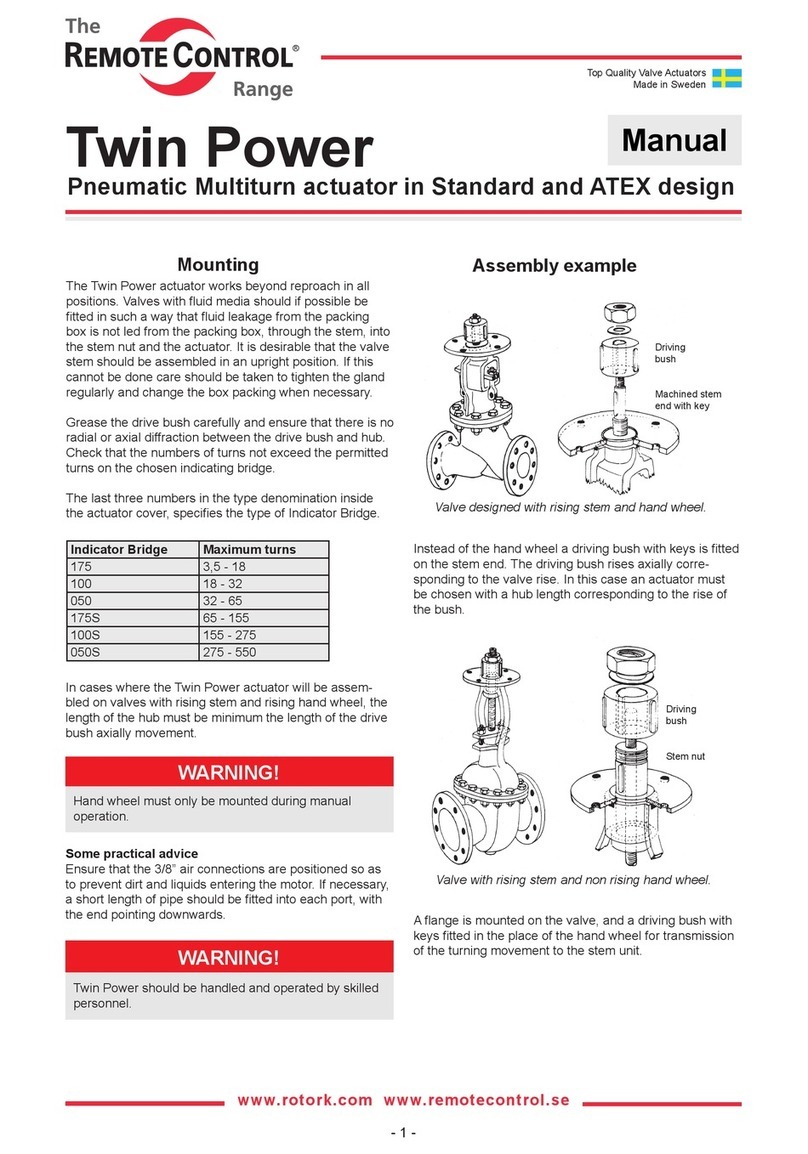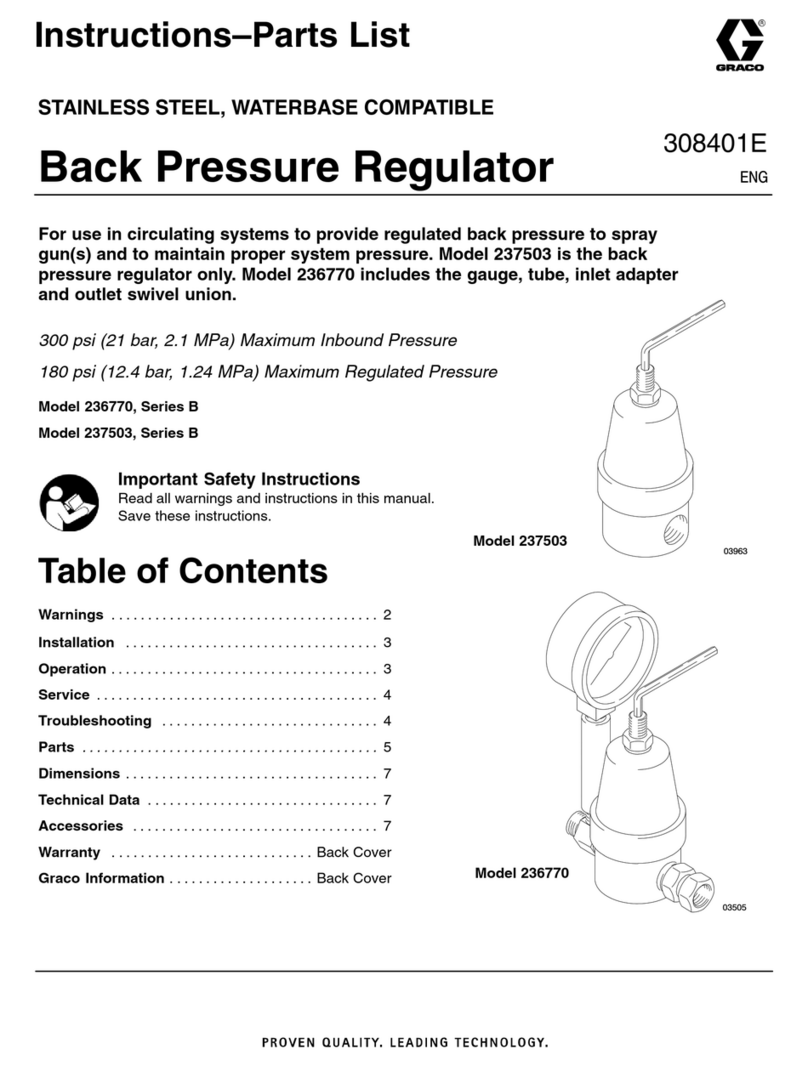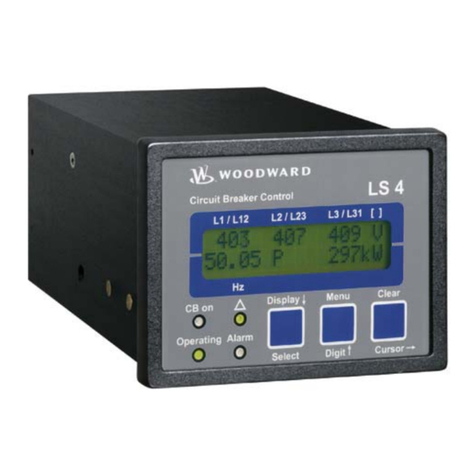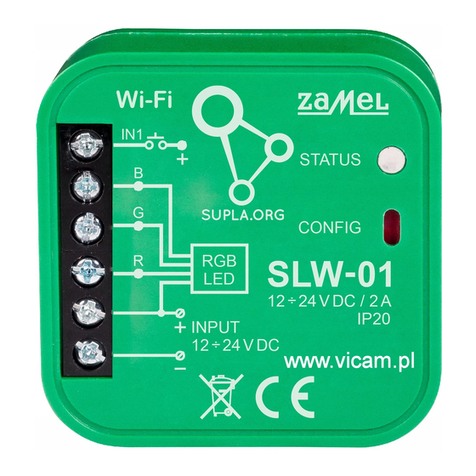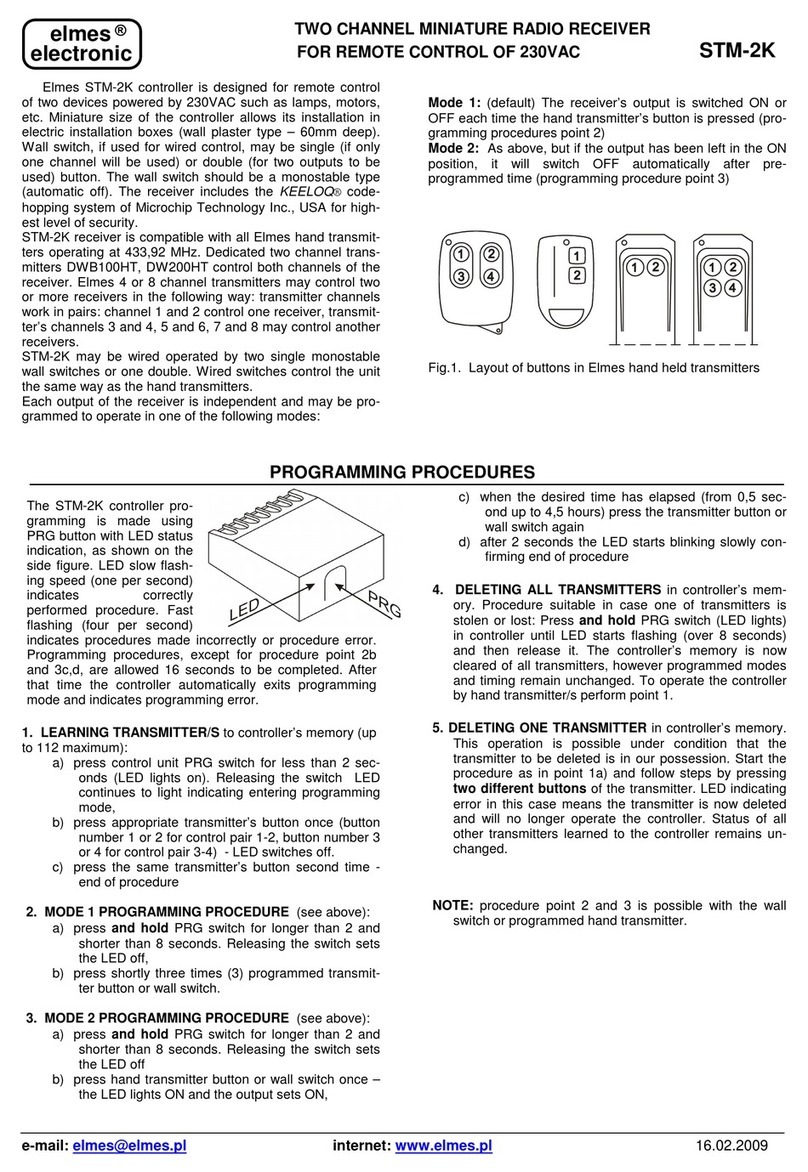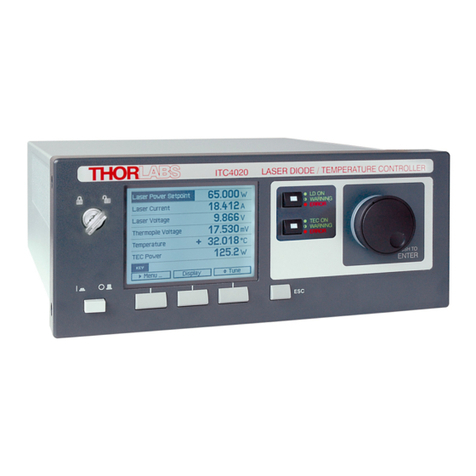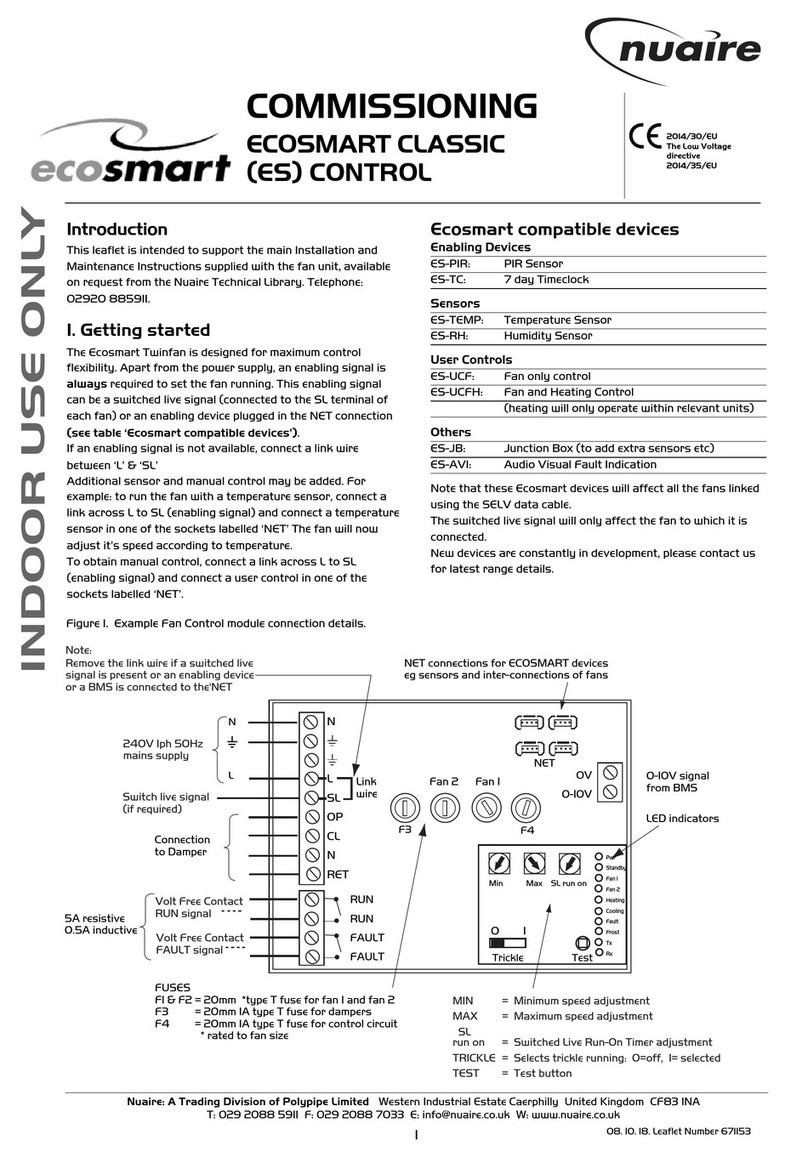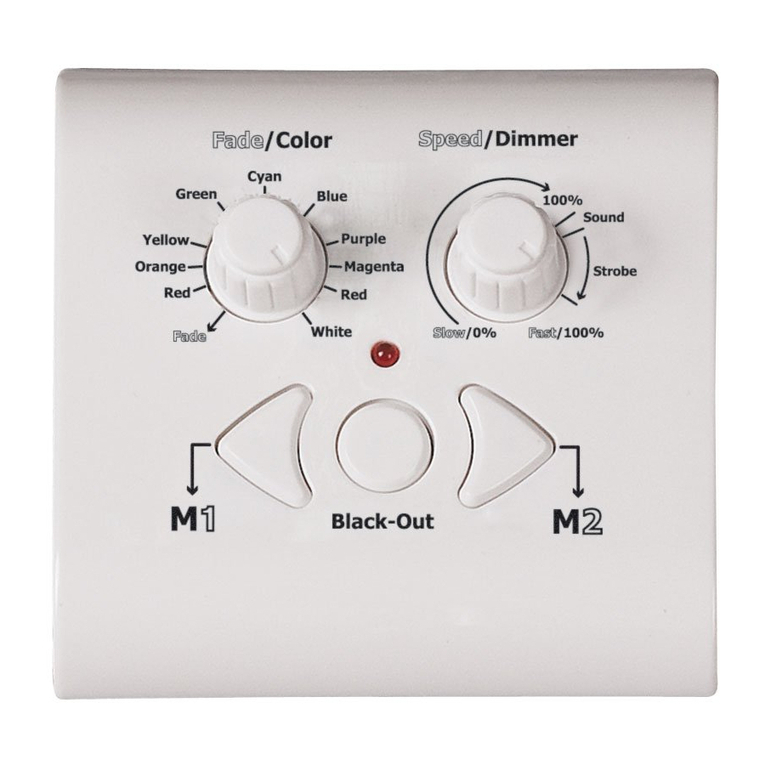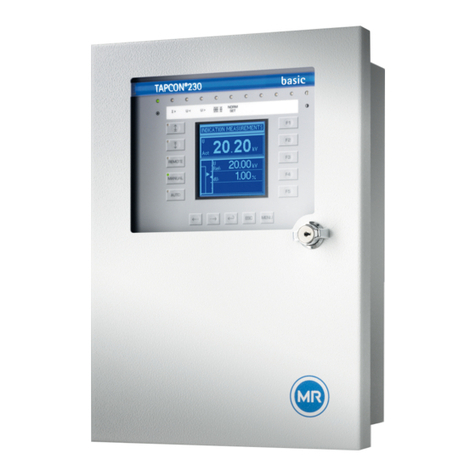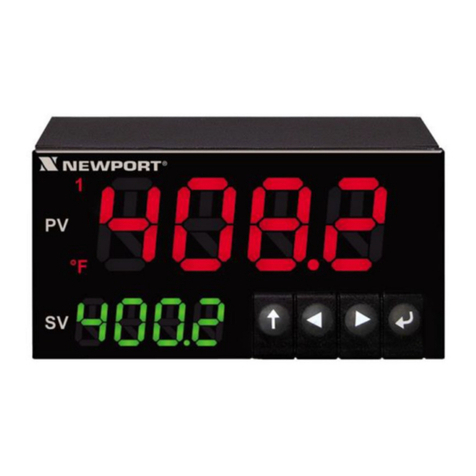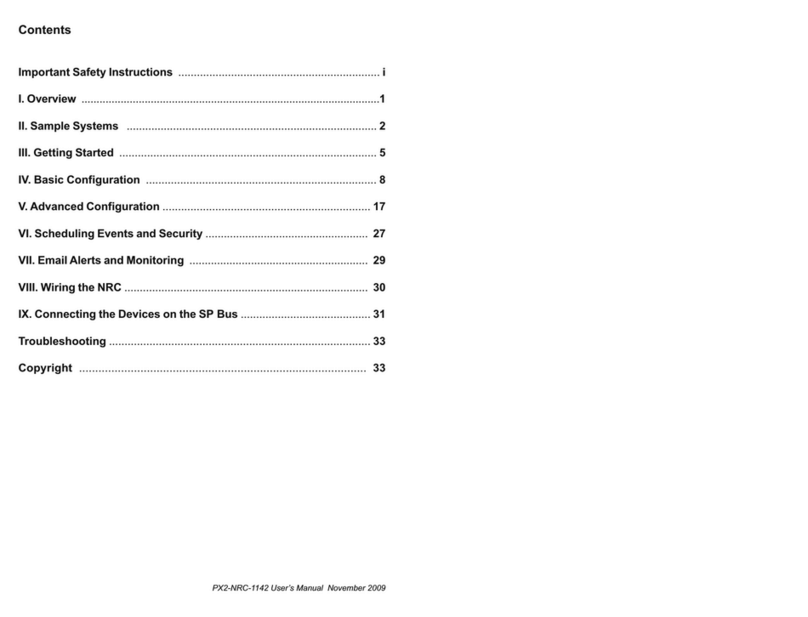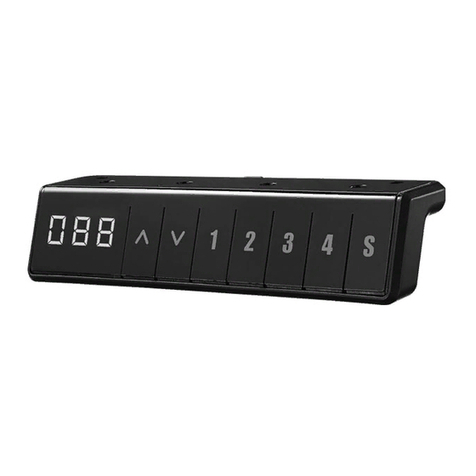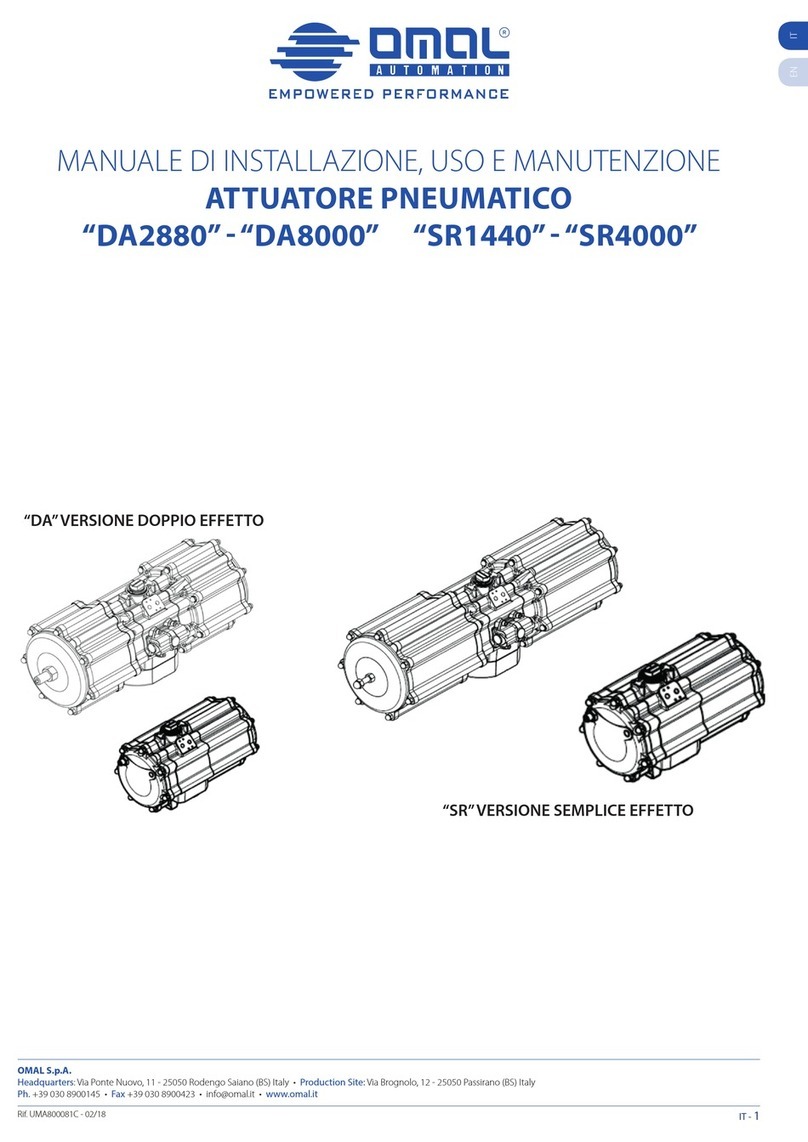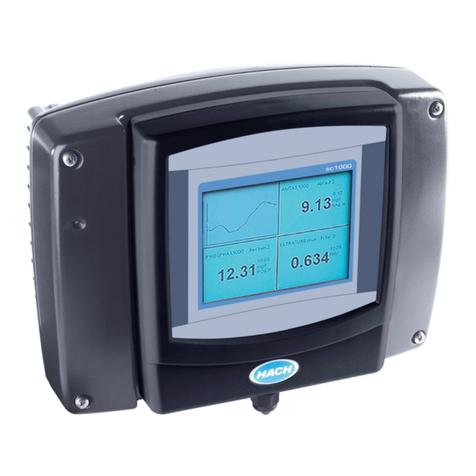ACS contsys MIR-491 User manual

MIR-491
MIR-49
1
Industrial and process controller MIR-491
Operating manual
English
BAL-491-65511
Valid from: 07/2002
ACS-Control System GmbH

© ACS-Control System GmbH •Printed in Germany (0207)
All rights reserved. No part of this document may be reproduced or published in any form or by any means
without prior written permission from the copyright owner.
A publication of ACS-Control System GmbH
Lauterbachstraße 57 1/2
D-84307 Eggenfelden
Germany
BlueControl
More efficiency in engineering,
more overview in operating:
The projecting environment for the controller MIR-491
ATTENTION!
Mini Version and Updates on
www.acs-controlsystem.d
e
Description of symbols:
gGeneral information
aGeneral warning
lAttention: ESD sensitive devices

Contents
1Mounting ..............................5
2Electrical connections .......................6
2.1 Connecting diagram .........................6
2.2 Terminal connection.........................7
3Operation .............................10
3.1 Front view .............................10
3.2 Behaviour after power-on .....................11
3.3 Operating level ...........................11
3.4 Mainenance manager / Error list ..................12
3.5 Self-tuning .............................14
3.5.1 Selecting the method ( ConF/Cntr/tunE).............15
3.5.2 Self-tuning start .............................15
3.5.3 Optimization at the set-point ......................16
3.5.4 Self-tuning cancellation .........................17
3.5.5 Acknowledgement procedures in case of unsuccessful self-tuning. . . 17
3.5.6 Examples for self-tuning attempts ...................17
3.6 Manual self-tuning .........................19
3.7 Alarm handling...........................20
3.8 Operating structure.........................21
4Configuration level ........................22
4.1 Configuration survey........................22
4.2 Configuration parameters .....................23
4.3 Set-point processing ........................39
4.4 MIR-491 cooling functions ....................40
4.4.1 Standard ( CyCl=0) .........................40
4.4.2 Water cooling linear ( CyCl=1)...................40
4.4.3 Water cooling non-linear ( CyCl=2).................41
4.4.4 Heating and cooling with constant period ( CyCl=3)........42

4.5 Configuration examples ......................43
4.5.1 Signaller (inverse) ............................43
4.5.2 2-point controller (inverse) .......................44
4.5.3 3-point controller (relay & relay) ....................45
4.5.4 3-point stepping controller (relay & relay) ...............46
4.5.5 Continuous controller (inverse) .....................47
4.5.6 ∆-Y - Off controller ..........................48
4.5.7 MIR-491 with measured value output..................49
5Parameter setting level ......................50
5.1 Parameter survey ..........................50
5.2 Parameters .............................51
5.3 Input scaling ............................53
5.3.1 Input Inp.1 and InP.3 ........................54
5.3.2 Input InP.2...............................54
5.4 Second set of parameters......................54
6Calibration level .........................55
7Special functions .........................58
7.1 DAC®– motor actuator monitoring ...............58
7.2 MIR-491 as Modbus master ....................60
8BlueControl ............................61
9Versions ..............................62
10 Technical data...........................63
11 Safety hints ............................68
11.1 Resetting to factory setting.....................69
12 Notes ................................70
13 Index ................................74

1Mounting
Safety switch:
For access to the safety switch, the controller must be withdrawn from the
housing. Squeeze the top and bottom of the front bezel between thumb and
forefinger and pull the controller firmly from the housing.
1Factory setting 2Default setting: display of all levels
suppressed, password PASS =OFF
lCaution! The unit contains ESD-sensitive components.
Mounting
Operating manual MIR-491 5
or:
%
max.
95% rel.
max. 60°C
0°Cmin.
96 (3.78")
48 (1.89")
Loc
min.48 (1.89")
10 (0.4")
1..10
(0.04..0.4")
118 (4.65")
45
+0,6
(1.77" )
+0.02
92
+0, 8
(3.62" )
+0. 03
*
Ü
*
Ü
Safety switch
MIR-491
123
è
1200
1199
°C
°F
SP.2
SP.E
para
func
Ada
Err
4
Loc open Access to the levels is as adjusted by means of
BlueControl (engineering tool) 2
closed 1all levels accessible wihout restriction

2Electrical connections
2.1 Connecting diagram
gThe controller is fitted with flat-pin terminals 1 x 6,3mm or 2 x 2,8mm
to DIN 46 244
Electrical connections
Connecting diagram 6 Operating manual MIR-491
1
3
4
5
6
7
8
9
10
11
12
13
14
15
17
(2)
(16)
mA
(mV)
(mV)
Volt
mA
INP2
INP3
INP1
di2
di1
1
2
3
4
5
6
7
8
9
10
11
12
13
14
15
Option
1
2
3
4
5
6
7
8
9
10
11
12
13
14
15
17
(16)
OUT1
OUT2
OUT3
OUT4
90...250V
24VUC
0%
100%
V
V
mA
HC
KS90-1. -2
5
...
KS90-1. -4...
KS90-1. -5...
KS90-1..-.1...
di2
di3
UT
RXD-B
GND
RXD-A
TXD-B
TXD-A
RS485 RS422
Modbus RTU
RGND
DATA B
DATA A
9
0
8
3
2
17
6
5
4
abcd
e
a
b
a
bc
d
e
+24V DC
24V GND
OUT5
OUT6
!

2.2 Terminal connection
Power supply connection 1
See chapter 10 "Technical data"
Connection of outputs OUT1/2 2
Relay outputs (250V/2A), potential-free
changeover contact
Connection of outputs OUT3/4 3
arelay (250V/2A), potential-free
changeover contact
universal output
bcurrent (0/4...20mA)
cvoltage (0/2...10V)
dtransmitter supply
elogic (0..20mA / 0..12V)
Connection of input INP1 4
Input for variable x1 (process value)
athermocouple
bresistance thermometer (Pt100/ Pt1000/ KTY/ ...)
ccurrent (0/4...20mA)
dvoltage (0/2...10V)
Connection of input INP2 5
aHeating current input (0...50mA AC)
or input for ext. set-point
(0/4...20mA)
bPotentiometer input for position
feedback
Connection of input INP3 6
As input INP1, but without voltage
Connection of inputs di1, di2 7
Digital input, configurable as switch or
push-button
Connection of inputs di2/3 8(option)
Digital inputs (24VDC external),
galvanically isolated, configurable as switch or push-button
Electrical connections
Operating manual MIR-491 7 Terminal connection
L
N
+
_
SSR
3
4
5
6
9
10
11
12
13
14
15
1
2
3
4
5
8
9
10
11
12
13
14
15
17
(16)
2
1
8
7
6
7
Logik
5INP2 current tansformer
6
9
10
11
12
13
14
15
1
2
3
4
5
6
7
8
9
10
11
12
13
14
17
(16)
L
N
+
5
43
2
1
8
7
15
2OUT1/2 heating/cooling

Connection of output UT9(option)
Supply voltage connection for external energization
Connection of outputs OUT5/6 0(option)
Digital outputs (opto-coupler), galvanic isolated, common positive control
voltage, output rating: 18...32VDC
Connection of bus interface !(option)
RS422/485 interface with Modbus RTU protocol
aIf the universal output OUT3 or
OUT4 is used there may be no
external galvanic connection
between measuring and output
circuits!
* Interface description Modbus RTU in speperate manual: see page 62.
Electrical connections
Terminal connection 8 Operating manual MIR-491
1
2
3
K
+
-
+
-
13V
22mA
13
14
15
11
12 13
17
(16)
14
15
12
11
10
3OUT3 transmitter supply
13
14
15
Option
17
(16)
1
3
4
5
6
7
8
9
10
11
12
13
14
15
17
(2)
(16)
+24VDC
5mA
5mA
0V
1
2
3
K
+
-
+
-
17,5V
22mA
14
13
+
-
15
OUT3
10
11
12
x
J
J
89 di2/3, 2-wire transmitter supply
1
3
4
5
6
7
8
9
10
11
12
13
14
15
17
(2)
(16)
option
1
3
4
5
6
7
8
9
10
11
12
13
14
15
17
(2)
(16)
option
1
3
4
5
6
7
8
9
10
11
12
13
14
15
17
(2)
(16)
option
11
12
13
14
15
10
11
12
13
14
15
10
11
12
13
14
15
RGND RGND RGND
RT
RS485-RS232
converter
PC
DATA A
DATA B
DATA A
DATA B
DATA A
DATA B
J
max. 1000m
"Twisted Pair” cable
10
RT
R=100 Ohm
RGND connection optional
R = 120...200 OhmT
R = 120...200 OhmT
9RS485 interface (with RS232-RS485 interface converter) *

MIR-491 connecting example:
aCAUTION: Using a temperature limiter is recommendable in
systems where overtemperature implies a fire hazard or
other risks.
Electrical connections
Operating manual MIR-491 9 Terminal connection
12
+
_
SSR
+
_
SSR
+
_
SSR
Series connection
Parallel connection
+
_
SSR
+
_
SSR
4V
4V
4V 12V
I =22mA
max
I =22mA
max
12V 11
10
10
11
12
Logic
3OUT3 as logic output with solid-state relay (series and parallel connection)
+
_
L
1
L2
N1
N2
Fuse
1
2
3
4
7
5
8
6
9
10
11
12
13
14
15
Fuse
TB 40-1
Temperature limiter
1
Fuse
SSR
Reset
key
Contactor
Heating
1TB 40-1 Temperature limiter
Standard version (3 relays):
TB40-100-0000D-000
Product of the PMA Prozeß- und
Maschinen-Automation GmbH
r
++
3
4
5
6
7
8
9
11
13
14
15
1
2
3
4
5
6
7
8
9
10
11
12
13
14
17
(16)
15
2
1
12
10
Logik
MIR-491

3Operation
3.1 Front view
LED colours:
LED 1, 2, 3, 4: yellow
Bargraph: red
other LEDs: red
gIn the upper display line, the process value is always displayed. At parameter,
configuration, calibration as well as extended operating level, the bottom display
line changes cyclically between parameter name and parameter value.
Operation
Front view 10 Operating manual MIR-491
MIR-491
123
(
1
2
3
4
5
6
$
7
8
%
&
(
è
è
è
/
1200
1199
°C
°F
SP.2
SP.E
para
func
Ada
Err
4
6
7
7
8
3
4
5
9
0
SP.2
E
§" !
rr
§"
"
1Status of switching outputs
OuT.1... 6
2Process value display
3Set-point, controller output
4Signals display on °C or °F
5Signals ConF and PArA level
6Signals aktive function key
7Self-tuning active
8Entry in error list
9Bargraph or clear text display
0SP.2 is effective
!SP.E is effective
"Set-point gradient effective
§Manual/automatic switch-over:
Off: Automatic
On: Manual
(changing possible)
Blinks: Manual
(changing not possible
(rConF/Cntr/MAn)
$Enter key:
calls up extended operating
level / error list
%Up/down keys:
changing the set-point or the
controller output value
&Manual mode /spec. function
(→ConF /LOGI )
/Freely programmable function
key
(PC connection for
BlueControl (engineering
tool)

3.2 Behaviour after power-on
After supply voltage switch-on, the unit starts with the operating level.
The unit is in the condition which was active before power-off.
If MIR-491 was in manual mode before power-off, the controller starts with
correcting value Y2 after switching on again.
3.3 Operating level
The content of the extended operating level is determined by means of
BlueControl (engineering tool). Parameters which are used frequently or the
display of which is important can be copied to the extended operating level.
Operation
Operating manual MIR-491 11 Behaviour after power-on
Ò
Ò
Ù
Ù
Ù
Ù
A
utomat
i
c
Extended operating level
M
anua
l
i
i
only
display
switching
Display
Error list (if error exists)
Y21
1199
1200
1199
È
Ì
È
Ì
Y21
1199
1200
1199
È
Ì
FbF.1
126
Err
2
126
Err
time
out
time
out
time
out

3.4 Mainenance manager / Error list
With one or several errors, the extended operating level
always starts with the error list. Signalling an actual entry
in the error list (alarm, error) is done by the Err LED in
the display. To reach the error list press Ùtwice.
Error list:
Operation
Mainenance manager / Error list 12 Operating manual MIR-491
1200
1199
°C
°F
SP.2
SP.E
para
func
Ada
Err
Err LED status Signification Proceed as follows
blinks Alarm due to existing error -Determine the error type in the error list
via the error number
-Remove the error
lit Error removed,
Alarm not acknowledged -Acknowledge the alarm in the error list
pressing key Èor Ì
-The alarm entry was deleted.
off No error,
all alarm entries deleted
Name Description Cause Possible remedial action
E.1 Internal error,
cannot be removed - E.g. defective EEPROM - Contact ACS service
- Return unit to our factory
E.2 Internal error, can be reset - e.g. EMC trouble - Keep measurement and power
supply cables in separate runs
- Ensure that interference
suppression of contactors is
provided
E.3 Configuration error,
can be reset -wrong configuration
-missing configuration
-Check interaction of
configuration / parameters
FbF.1 Sensor break INP1 -Sensor defective
-Faulty cabling
-Replace INP1 sensor
-Check INP1 connection
Sht.1 Short circuit INP1 -Sensor defective
-Faulty cabling
-Replace INP1 sensor
-Check INP1 connection
POL.1 INP1polarity error -Faulty cabling -Reverse INP1 polarity
FbF.2 Sensor break INP2 -Sensor defective
-Faulty cabling
-Replace INP2 sensor
-Check INP2 connection
Sht.2 Short circuit INP2 -Sensor defective
-Faulty cabling
-Replace sensor INP2
-Check INP2 connection
POL.2 INP2 polarity -Faulty cabling -Reverse INP2 polarity
FbF.3 Sensor break INP3 -Sensor defective
-Faulty cabling
-Replace INP3 sensor
-Check INP3 connection
Sht.3 Short circuit INP3 -Sensor defective
-Faulty cabling
-Replace sensor INP3
-Check INP3 connection
POL.3 INP3 polarity -Faulty cabling -Reverse INP3 polarity

gSaved alarms (Err-LED is lit) can be acknowledged and deleted with the digital
input di1/2/3, the è-key or the Ò-key.
Configuration, see page 30: ConF /LOGI /Err.r
gIf an alarm is still valid that means the cause of the alarm is not removed so far
(Err-LED blinks), then other saved alarms can not be acknowledged and deleted.
Error status:
Operation
Operating manual MIR-491 13 Mainenance manager / Error list
Name Description Cause Possible remedial action
HCA Heating current alarm (HCA) -Heating current circuit
interrupted, I< HC.A or I>
HC.A (dependent of
configuration)
-Heater band defective
-Check heating current circuit
-If necessary, replace heater
band
SSr Heating current short circuit
(SSR) -Current flow in heating circuit
with controller off
-SSR defective
-Check heating current circuit
-If necessary, replace
solid-state relay
LooP Control loop alarm (LOOP) -Input signal defective or not
connected correctly
-Output not connected correctly
-Check heating or cooling
circuit
-Check sensor and replace it, if
necessary
-Check controller and
switching device
AdA.H Self-tuning heating alarm
(ADAH) -See Self-tuning heating error
status
-see Self-tuning heating error
status
AdA.C Self-tuning heating alarm
cooling (ADAC) - See Self-tuning cooling error
status
- see Self-tuning cooling error
status
LiM.1 stored limit alarm 1 - adjusted limit value 1 exceeded - check process
Lim.2 stored limit alarm 2 - adjusted limit value 2 exceeded - check process
Lim.3 stored limit alarm 3 - adjusted limit value 3 exceeded - check process
Inf.1 time limit value message - adjusted number of operating
hours reached
- application-specific
Inf.2 duty cycle message
(digital ouputs) - adjusted number of duty cycles
reached
- application-specific
Error status Signification
2Existing error Change to error status 1 after error removal
1Stored error Change to error status 0 after acknowledgement in error list
0No error/message not visible, except with acknowledgement

Self-tuning heating ( ADA.H) and cooling ( ADA.C) error status:
DAC function ( DAC) error status:
3.5 Self-tuning
After starting by the operator, the controller makes a self-tuning attempt. The
controller uses the process characteristics for quick line-out to the set-point
without overshoot.
gSelf-tuning start can be locked via BlueControl (engineering tool) ( P.Loc).
gti and td are taken into account only, if they were ≠OFF previously.
Operation
Self-tuning 14 Operating manual MIR-491
Error status Description Behaviour
0No error
3Faulty control action Re-configure controller (inverse idirect)
4No response of process
variable The control loop is perhaps not closed: check sensor,
connections and process
5Low reversal point Increase ( ADA.H) max. output limiting Y.Hi or
decrease ( ADA.C) min. output limiting Y.Lo
6Danger of exceeded set-point
(parameter determined) If necessary, increase (inverse) or reduce (direct) set-point
7Output step change too small
(dy > 5%) Increase ( ADA.H) max. output limiting Y.Hi or reduce
(ADA.C) min. output limiting Y.Lo
8Set-point reserve too small Increase set-point (invers), reduce set-point (direct)
or increase set-point range
(rPArA /SEtp /SP.LO and SP.Hi )
9Impulse tuning failed The control loop is perhaps not closed: check sensor,
connections and process
Error status Description Behaviour
0No error
3Output is blocked Check the drive for blockage
4Wrong method of operation Wrong phasing, defect motor capacitor
5Fail at Yp measurement Check the connection to the Yp input
6Calibration error Manual calibration necessary

3.5.1 Selecting the method ( ConF/Cntr/tunE)
tunE =0Step attempt during start-up (if X SP - 60 K):
The controller outputs 0% or Y.Lo and waits, until the process
is at rest. This is followed by:
2-point controller: step attempt for heating loop. Then,
the determined parameters are used for
line-out to the set-point.
3-point controller:as2-point controller. Now, the heating
output is frozen and a cooling pulse
(100%) for the cooling loop is output.
After determination of cooling parameters,
control is continued using the heating
and cooling parameters.
tunE =1Pulse attempt during start-up (if X SP - 60 K):
Controller outputs 0% or Y.Lo and waits, until the process is
at rest. This is followed by:
2-point controller: pulse attempt (100%) for heating loop.
followed by line-out to the set-point using
the determined parameters.
3-point controller:as2-point controller. The heating output
is frozen and a cooling pulse (100%) for
the cooling loop is output.
After determination of cooling parameters,
control is continued using the heating
and cooling parameters.
tunE =2Always step attempt during start-up: see TunE =0
gWith 3-point stepping controller configured, only the step attempt after start-up
is available for self-tuning ( tunE =0).
3.5.2 Self-tuning start
Strt =0Only manual start by pressing keys Ùand È
simultaneously or via interface is possible.
Strt =1Manual start by press keys Ùand Èsimultaneously
via interface and automatic start after power-on and detection
of process oscillations.
gIf the process value is higher than the set-point minus 60 K (X ≥SP-60K)and
self-tuning is started manually, the control to the set-point is using the old
parameters followed by an optimization at the set-point.
Operation
Operating manual MIR-491 15 Self-tuning

gIf the process value is smaller than the set-point minus 60 K (X ≤SP-60K),
self-tuning after start-up is done automatically by the controller ( tunE =0/1).
gIf the controller detects process oscillations of more than ±2,5K with
Strt =1configured, the control parameters are preset for calming the process
followed by optimization at the set-point.
3.5.3 Optimization at the set-point
With the difference between process value and set-point smaller than 60 K and
self-tuning started manually, optimization at the set-point is used.
For this, control to the set-point is using the control parameters.
When the process value has reached the set-point, a pulse attempt with reduced
correcting variable (for process protection, max. 20%) is made with the active
loop (Y>0 heating pulse, Y<0 cooling pulse). I.e. by optimization at the
set-point, the optimum control parameters either for the heating or the cooling
loop are determined.
The correcting variable pulse can be output by the controller in positive or
negative direction. If possible, the controller outputs a pulse in negative direction
(process protection against temperature increase).
+In which case does the controller use the optimization at the set-point?
wProcess ≥set-point - 60K with manual self-tuning start
wafter step attempt failure after start-up or power-on
wwith active gradient ( PArA/SETP/r.SP≠OFF) and manual self-tuning
start or self-tuning start after power on
wwith active start-up circuit ( ConF /Cntr /SP.Fn =10) and manual
self-tuning start or self-tuning start after power-on
Operation
Self-tuning 16 Operating manual MIR-491
Ada LED status Signification
blinks Waiting, until process
calms down
lit Self-tuning is running
off Self-tuning not activ
or ended
1200
1199
°C
°F
SP.2
SP.E
para
func
Ada
Err

3.5.4 Self-tuning cancellation
By the operator:
Self-tuning can always be cancelled by the operator. For this, press Ùand È
key simultaneously. With manual-automatic switch-over configured via Òkey,
self-tuning can also be canceled by actuating Òkey. The controller continues
operating with the old parameters in automatic mode in the first case and in
manual mode in the second case.
By the controller:
If the Err LED starts blinking whilst self-tuning is running, successful self-tuning
is prevented due to the control conditions. In this case, self-tuning was cancelled
by the controller. The controller continues operating with the old parameters in
automatic mode. In manual mode it continues with the old controller output
value.
3.5.5 Acknowledgement procedures in case of unsuccessful self-tuning
1. Press keys Ùand Èsimultaneously:
The controller continues controlling using the old parameters in automatic
mode. The Err LED continues blinking, until the self-tuning error was
acknowledged in the error list.
2. Press key Ò(if configured):
The controller goes to manual mode. The Err LED continues blinking,
until the self-tuning error was acknowleged in the error list.
3. Press key Ù:
Display of error list at extended operating level. After acknowledgement
of the error message, the controller continues control in automatic mode using
the old parameters.
Cancellation causes:
rpage 14: "Error status self-tuning heating ( ADA.H) and cooling ( ADA.C)"
3.5.6 Examples for self-tuning attempts
(controller inverse, heating or heating/cooling)
Start: heating power switched on
Heating power Y is switched off (1).
When the change of process value X
was constant during one minute (2),
the power is switched on (3).
At the reversal point, the self-tuning
attempt is finished and the new
parameter are used for controlling to
set-point W.
Operation
Operating manual MIR-491 17 Self-tuning
t
2
100%
Y
0%
X
W
Start r13treversal point
blinks

Start: heating power switched off
The controller waits 1,5 minutes (1).
Heating power Y is switched on (2).
At the reversal point, the self-tuning
attempt is finished and control to the
set-point is using the new parameters.
Self-tuning at the set-point a
The process is controlled to the
set-point. With the control deviation
constant during a defined time (1),
i.e. with the process value equal to the
set-point, the controller outputs a
reduced correcting variable pulse
(max. 20%) (2). After determination
of the control parameters using the
process characteristic (3), control is
started using the new parameters
(4).
Three-point controller a
The parameter for heating and cooling
are determined in two attempts. The
heating power is switched on (1).
Heating parameters Pb1,ti1,
td1 and t1 are determined at the
reversal point. The process is
controlled to the set-point (2). With
constant control deviation, the
controller provides a cooling
correcting variable pulse (3). After
determining its cooling parameters Pb2,ti2,td2 and t2 (4) from the
process characteristics , control operation is started using the new parameters
(5).
aDuring phase 3, heating and cooling are done simultaneously!
Operation
Self-tuning 18 Operating manual MIR-491
t
100%
Y
0%
X
W
start r12treversal point
blinks
t
2
100%
Y
0%
X
W
13
blinks
4
rt
Start r
t
+100%
Y0%
-100%
X
W
treversal
point
Start r12
3
45
rt

3.6 Manual self-tuning
The optimization aid should be used with units on which the control parameters
shall be set without self-tuning.
For this, the response of process variable x after a step change of correcting
variable y can be used. Frequently, plotting the complete response curve (0 to
100%) is not possible, because the process must be kept within defined limits.
Values Tgand xmax (step change from 0 to 100 %) or ∆t and ∆x (partial step
response) can be used to determine the maximum rate of increase vmax.
The control parameters can be determined from the values calculated for delay
time Tu, maximum rate of increase vmax, control range Xhand characteristic K
according to the formulas given below. Increase Xp, if line-out to the set-point
oscillates.
Operation
Operating manual MIR-491 19 Manual self-tuning
Formulas
K = Vmax * Tu controller behavior Pb1 [phy. units] td1 [s] ti1 [s]
With 2-point and
3-point controllers,
the cycle time must be
adjusted to
t1 /t2 ≤0,25 * Tu
PID 1,7*K 2*Tu 2*Tu
PD 0,5 * K Tu OFF
PI 2,6 * K OFF 6*Tu
PKOFF OFF
3-point-stepping 1,7 * K Tu 2 * Tu
Parameter adjustment effects
Parameter Control Line-out of disturbances Start-up behaviour
Pb1 higher increased damping slower line-out slower reduction of duty cycle
lower reduced damping faster line-out faster reduction of duty cycle
td1 higher reduced damping faster response to disturbances faster reduction of duty cycle
lower increased damping slower response to disturbances slower reduction of duty cycle
ti1 higher increased damping slower line-out slower reduction of duty cycle
lower reduced damping faster line-out faster reduction of duty cycle
Tu
Tg
t
x
y
100%
0%
t
Yh
Xmax
{X
{t
y = correcting variable
Yh= control range
Tu = delay time (s)
Tg = recovery time (s)
Xmax = maximum process value
Vmax =Xmax
Tg ={
{
x
t=max. rate of
increase of process value

3.7 Alarm handling
Max. three alarms can be configured and assigned to the individual outputs.
Generally, outputs OuT.1... OuT.6 can be used each for alarm signalling. If
more than one signal is linked to one output the signals are OR linked. Each of
the 3 limit values Lim.1 …Lim.3 has 2 trigger points H.x (Max) and L.x (Min),
which can be switched off individually (parameter = “OFF”). Switching
difference HYS.xof each limit value is adjustable.
1: normally closed ( ConF/Out.x/O.Act=1)
2: normally open ( ConF/Out.x/O.Act=0)
Operation
Alarm handling 20 Operating manual MIR-491
L.1
LED LED
HYS.1 HYS.1
H.1
InL.1 InH.1
SP
22
1
H.1
LED
HYS.1
InL.1 InH.1
2
1
ÜOperaing principle Src.x=0,6,7
L.1 =OFF
LED
HYS.1
H.1
InL.1 InH.1
SP
2
1
*Operating principle Src.x=1,2
L.1 =OFF
L.1
LED
HYS.1
InL.1 InH.1
21
H.1 =OFF
L.1
LED
HYS.1
InL.1 InH.1
SP
21
H.1 =OFF
L.1
LED LED
HYS.1 HYS.1
H.1
InL.1 InH.1
2
21
Other manuals for MIR-491
1
Table of contents
Other ACS contsys Controllers manuals

